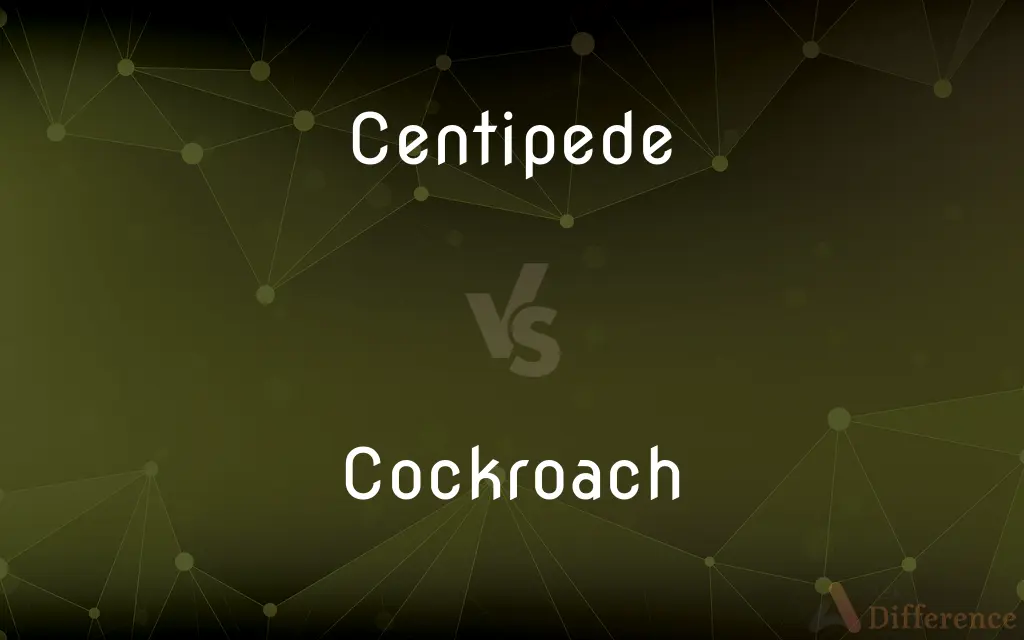Centipede vs. Cockroach — What's the Difference?
By Maham Liaqat & Fiza Rafique — Updated on March 18, 2024
Centipedes are elongated, many-legged predators, while cockroaches are flat-bodied insects known for their resilience and rapid reproduction.

Difference Between Centipede and Cockroach
Table of Contents
ADVERTISEMENT
Key Differences
Centipedes, belonging to the class Chilopoda, are carnivorous arthropods known for their numerous legs, one pair per body segment, and are natural predators, hunting smaller insects. Cockroaches, in the order Blattodea, are notorious for their hardiness and ability to thrive in various environments, often considered pests in human habitats.
Centipedes have a more segmented body structure with a pair of venomous claws behind their head used for hunting, while cockroaches have a broad, flat body with a head concealed beneath a pronotum, and lack venomous features, relying on their speed and nocturnal habits for survival.
The habitat of centipedes is often moist and dark places like soil and leaf litter, providing a conducive environment for their predatory lifestyle, whereas cockroaches are more adaptable, inhabiting a wide range of environments from tropical forests to urban dwellings, often in close association with human activity.
Reproduction in centipedes involves the male depositing a spermatophore for the female to find and fertilize her eggs, leading to relatively low offspring numbers. Cockroaches, on the other hand, reproduce rapidly, with females producing large numbers of eggs in protective cases, contributing to their status as persistent pests.
Centipedes and cockroaches play distinct roles in their ecosystems; centipedes act as important predators, helping control populations of smaller insects, while cockroaches are decomposers, breaking down organic material and recycling nutrients, despite their often negative perception.
ADVERTISEMENT
Comparison Chart
Classification
Class Chilopoda
Order Blattodea
Body Structure
Elongated, segmented
Broad, flat
Legs
One pair per segment, many-legged
Six legs
Diet
Carnivorous, preying on small insects
Omnivorous, eating a variety of organic matter
Venom
Have venomous claws for hunting
Lack venomous features
Habitat
Moist, dark environments like soil
Versatile, including urban and natural areas
Reproduction
Lower offspring numbers, spermatophore deposition
High reproduction rate, egg cases
Role in Ecosystem
Predators, controlling insect populations
Decomposers, recycling organic material
Compare with Definitions
Centipede
Carnivorous arthropods known for their multiple legs.
The garden centipede hunts other small insects.
Cockroach
Resilient insects with a broad, flat body.
The cockroach easily slipped into a crack due to its flat body.
Centipede
Have a segmented body with a pair of legs per segment.
Each segment of the centipede's body has a distinct pair of legs.
Cockroach
Omnivorous pests often found in human habitats.
Cockroaches in the kitchen are a common nuisance.
Centipede
Utilize venomous claws to capture prey.
The centipede used its venomous claws to immobilize the insect.
Cockroach
Reproduce rapidly, making them difficult to eradicate.
The cockroach population in the apartment increased quickly.
Centipede
Prefer moist and dark habitats.
Centipedes thrive in the dampness under rocks and logs.
Cockroach
Play a role in decomposing organic matter.
Cockroaches contribute to the ecosystem by breaking down waste.
Centipede
Known for their quick and agile movements.
The centipede quickly scurried away when exposed to light.
Cockroach
Can survive in a variety of environments.
Cockroaches are found in both tropical forests and urban areas.
Centipede
Any of various predatory arthropods of the class Chilopoda, having a long flattened body composed of segments, each bearing a pair of jointed appendages. The appendages of the foremost body segment are modified into venomous claws. Also called chilopod.
Cockroach
Cockroaches (or roaches) are insects of the order Blattodea, which also includes termites. About 30 cockroach species out of 4,600 are associated with human habitats.
Centipede
Centipedes (from the New Latin prefix centi-, "hundred", and the Latin word pes, pedis, "foot") are predatory arthropods belonging to the class Chilopoda (Ancient Greek χεῖλος, kheilos, lip, and New Latin suffix -poda, "foot", describing the forcipules) of the subphylum Myriapoda, an arthropod group which also includes millipedes and other multi-legged creatures. Centipedes are elongated metameric creatures with one pair of legs per body segment.
Cockroach
Any of numerous insects of the order or suborder Blattaria, having oval flat bodies and laying eggs in hardened cases, and including several species that are common household pests.
Centipede
Any arthropod of class Chilopoda, which have a segmented body with one pair of legs per segment and from about 20 to 300 legs in total.
Cockroach
A black or brown straight-winged insect of the order Blattodea.
Centipede
A species of the Myriapoda; esp. the large, flattened, venomous kinds of the order Chilopoda, found in tropical climates. they are many-jointed, and have a great number of feet.
Cockroach
A person or a member of a group of people regarded as undesirable and rapidly procreating.
Centipede
Chiefly nocturnal predacious arthropod having a flattened body of 15 to 173 segments each with a pair of legs the foremost being modified into poison fangs
Cockroach
A Tutsi.
Cockroach
A person from New South Wales.
Cockroach
A hard lump of brown sugar.
Cockroach
An orthopterous insect of the genus Blatta, and allied genera.
Cockroach
Any of numerous chiefly nocturnal insects; some are domestic pests
Common Curiosities
Can cockroaches cause harm in homes?
Cockroaches can spread diseases and allergens, making them a health concern in human habitats.
. Why are centipedes considered beneficial?
Centipedes control pest populations by preying on small insects, making them beneficial predators in gardens and ecosystems.
Why are cockroaches so hard to get rid of?
Cockroaches' rapid reproduction, resilience, and ability to hide in small spaces make them challenging to eradicate.
Are all centipedes venomous?
Most centipedes have venom to subdue prey, but not all pose a significant threat to humans.
Are centipedes nocturnal?
Many centipedes are nocturnal, hunting and being active at night to avoid predators and retain moisture.
How do cockroaches communicate?
Cockroaches communicate through chemicals called pheromones, which can indicate danger, food sources, or mating readiness.
Can centipedes be kept as pets?
Some centipede species are kept by enthusiasts, but they require careful handling due to their venom.
How do centipedes defend themselves?
Centipedes use their speed, venomous claws, and ability to coil up to defend against threats.
Can cockroaches survive without their head?
Cockroaches can survive for a period without their head due to their open circulatory system and slow need for oxygen.
Do centipedes lay eggs?
Centipedes lay eggs in soil or concealed locations, with the female sometimes guarding them until they hatch.
What attracts cockroaches to homes?
Cockroaches are attracted to food, water, and shelter, making homes ideal environments for them.
How do cockroaches affect ecosystems?
Cockroaches play a role in decomposing and recycling organic matter, contributing to nutrient cycles.
Can centipedes and cockroaches coexist in the same environment?
While they may share similar habitats, centipedes may predate on cockroaches due to their carnivorous nature.
What natural predators do centipedes have?
Centipedes are preyed upon by larger animals, including birds, mammals, and larger arthropods.
What is the lifespan of a cockroach?
Cockroach lifespans vary by species, but many live for about a year in ideal conditions.
Share Your Discovery

Previous Comparison
Background vs. Foundation
Next Comparison
Byssinosis vs. BagassosisAuthor Spotlight
Written by
Maham LiaqatCo-written by
Fiza RafiqueFiza Rafique is a skilled content writer at AskDifference.com, where she meticulously refines and enhances written pieces. Drawing from her vast editorial expertise, Fiza ensures clarity, accuracy, and precision in every article. Passionate about language, she continually seeks to elevate the quality of content for readers worldwide.














































